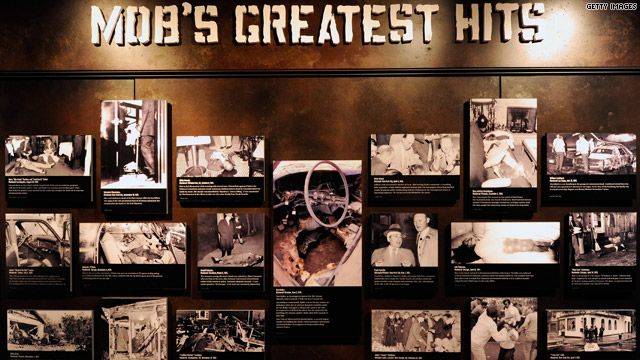Mobsters in Sin City
While I don’t scream for anti-defamation protests with every Olive Garden commercial, I was on ready to be miffed at too many violin cases and cannoli references when I took a quick spin around the Las Vegas Mob Museum a few months ago.
Timed to coincide with the anniversary of the St. Valentine’s Day Massacre, the grand opening of the National Museum of Organized Crime and Law Enforcement, or Mob Museum, took place two years ago, on February 14, 2012. Housed in the former federal courthouse for Clark County (an old three-story neoclassical building that was one of the locations for the 1950 organized crime Senate hearings, led by Senator Estes Kefauver), the museum takes full advantage Las Vegas’s connection to the popular imagination of the mob, repackaging it into a tidy, PG-rated spectacle.
In my limited time there I was mostly interested in understanding how the museum would handle the ethnicity issue—specifically the Italian Americans-as-mobsters conundrum.
I knew that the spot had been plagued by controversies even before it ever opened.The drive to open the museum was spearheaded by then-Las Vegas Mayor Oscar Goodman—a former defense lawyer for a number of high-level men accused of organized criminal activity. Goodman had a cameo roll in Scorsese’s Casino, playing himself defending De Niro’s character, Ace Rothstein.
Oddly enough, for the most part the museum seems almost to skirt the issue of the relationship between ethnicity and crime by basically never stating the obvious. In fact, specific ethnic or racial groups are barely pointed out at all. But that doesn’t mean that they aren’t there.
In the first “historical section,” visitors are shown through photographs and film images that the development of organized crime at the turn of the 20th century in the U.S. was mostly an immigrant phenomenon related to poverty and discrimination. With equal focus on the challenges faced by the triad of Irish, Jewish, and Italian immigrants, the museum notes describe a “secret criminal society” some immigrants brought “with them from Sicily”—thus setting one immigrant group apart from the others and suggesting that all further developments stemmed directly from this importation.
But as far as I could tell, after this origin story, such ethnic specificity never really comes up so clearly again, even though I have no doubt that the majority of the criminals referenced throughout the exhibits have names that end in vowels—for every Lansky, Stein, and McGrath were dozens of Boiardos, Genoveses, Accardos, and Cassos.
But the same could be said for the FBI and police names noted. In fact, Giuseppe “Joe” Petrosino is celebrated with a large plaque recognizing him as an “American Hero."
And the large wall space devoted to “case studies” of an undercover police officer, a strike force attorney, and a government witness also all bear Italian American names.
I walked through an impressive array of ephemera, archival media footage, and interactive displays that together construct a sensationalized but well-documented story: the development of Las Vegas as a city of gambling and spectacle played well with the culture of gangsters; the role of Lucky Luciano during World War II; the Kefauver hearings, when “Americans invited the mob into their home;” FBI wire-tapping and mapping of Northeastern neighborhoods; and descriptions of the everyday life of gangsters (wedding albums, prayer cards, golf clubs, high-security prison).
But what struck me again and again is that although Italian Americans dominated organized crime in the U.S. for decades, nothing was really being made of this fact.
Sure there were a handful of Italian-like references that seemed blatantly exploitative and unnecessary—like the fake Italian American grocer’s sign above the “Weapon Methods” section or the Warholesque MOB tomato cans display. But these moments were by and large rare among the 42,000-square-foot institution.
Even in the section on organized crime and popular culture, the predominance of Italian ethnic-specific mobsters in the movies wasn’t mentioned. In an age when gangsters and Italian Americans remain synonymous in popular imagination, the museum seems to go out of its way to underplay that connection, even to a fault.
The lack of references to ethnic, racial, or nationally specific trends (also glaringly absent in later gallery spaces devoted to contemporary organized crime on a global scale or to areas devoted to U.S. urban crime) throughout the museum seems misleading or disingenuous at best.
In the end, the Mob Museum is merely a very limited attraction set against the glitz and glamour of Sin City, so much so that I wonder if Jean Baudrillard would have even considered it part of the hyperreal that Las Vegas otherwise does so well.


































i-Italy
Facebook
Google+
This work may not be reproduced, in whole or in part, without prior written permission.
Questo lavoro non può essere riprodotto, in tutto o in parte, senza permesso scritto.